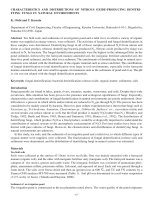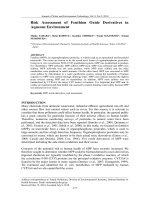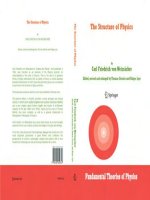- Trang chủ >>
- Khoa Học Tự Nhiên >>
- Vật lý
electronic structure of titanium oxide nanotubules
Bạn đang xem bản rút gọn của tài liệu. Xem và tải ngay bản đầy đủ của tài liệu tại đây (248.52 KB, 6 trang )
Electronic structure of titanium oxide nanotubules
Jian Hong, Jian Cao, Jingzhi Sun
*
, Hanying Li, Hongzheng Chen, Mang Wang
*
Department of Polymer Science and Engineering, State Key Laboratory of Silicon Materials,
Institute of Polymer Composites, Zhejiang University, Hangzhou 310027, PR China
Received 19 May 2003; in final form 18 August 2003
Published online: 2 October 2003
Abstract
We investigated the electronic states of titanium oxide nanotubules (TiO
x
-NTs) by using field induced surface
photovoltage spectroscopy (FISPS). Compared with common TiO
2
P25 nanocrystals, new surface photovoltage re-
sponse bands extending to 550 nm were found under the effect of external electric field. Based on the principle of FISPS,
these responses were ascribed to the surface state transitions. X-ray diffraction (XRD) indicated that the crystalline
structure changed remarkable during the hydrothermal synthesis process. The existence of oxygen vacancies contrib-
uting to the surface states was further confirmed by the sub-band gap photoluminescence.
Ó 2003 Elsevier B.V. All rights reserved.
1. Introduction
Recently, one-dimensional (1D) nanostructured
TiO
2
materials such as nanotubules, nanowires
have gained considerable attention for their bril-
liant prospects in photocatalyst, environment pu-
rification, solar cell and gas and humidity sensor
[1–4]. Various methods have been introduced to
acquire the 1D nanostructured TiO
2
. Using sol–gel
strategy, Hoyer [5] prepared TiO
2
nanotubes with
diameters of 70–100 nm. Applying porous alumina
template, Imai et al. [6] successfully fabricated
TiO
2
nanotubes in a tunable way. The simple
method of hydrothermal synthesis, first developed
by Kasuga et al. [7], was also extensively employed
to synthesize TiO
2
nanotubes, nanoribbons and
nanowires. Among these researches, however, the
efforts focus on the characterization of crystallo-
graphic structures and microscopic morphologies,
only little attentions have been paid to the elec-
tronic properties of these 1D nanostructured
materials. In fact, the electronic properties play a
key role in determining their photo/electronic
performance.
Considering that the surface photovoltage
spectrum (SPS) an d electric field-induced surface
photovoltage spectrum (FISPS) are highly sensi-
tive tools to study the photophysics of the photo-
generated species or excited states without any
sample-contamination and de struction [8,9], we
have investigated the surface electronic properties
of the titanium oxide nanotubules using the
SPS, FISPS techniques and photoluminescence
Chemical Physics Letters 380 (2003) 366–371
www.elsevier.com/locate/cplett
*
Corresponding authors. Fax: +86-571-8795-1635.
E-mail addresses: (J. Sun), mwang@zju.
edu.cn (M. Wang).
0009-2614/$ - see front matter Ó 2003 Elsevier B.V. All rights reserved.
doi:10.1016/j.cplett.2003.09.037
(PL) spectroscopy. In this Letter, we report
our experimental results, besides photovoltaic re-
sponse corresponding to band-to- band transition;
new surface photovoltage responses extended to
550 nm have been observed under the effect of the
external electric field. Based on the principle of
FISPS and the feature of PL, the new responses
can be assigned to the surface states, which are
resulted from oxygen vacancies formed in the
structural evolution of the raw materials TiO
2
P25
to the nanotubules.
2. Experimental
The method of hydrothermal synthesis, as de-
scribed by Kasuga et al. [7]. was employed to
prepare titanium oxide nanotubules. In a typical
experiment, 500 micr ogramme titanium dioxide
power (Degussa P25) and 50 ml 5–10 M NaOH
aqueous solutions was put together into a Teflon-
lined autoclave. The autoclave was sealed into a
stainless tank, and maintained the temperature at
180 °C for 24 h, without shaking or stirring. And
after it was cooled to room temperature, a white
tousy power was obtained by centrifugation. The
precipitate was washed with hydrochloric acid and
distilled water several times until the pH was 7,
and dried at 60 °C for 12 h, then annealed at
350 °C for 2 h, finally a soft white powder was
obtained.
SPS is a measurement of the relation between
the surface photovoltage vs. the light wavelength.
That is to say, the signal detected by SPS is
equivalent to the change in the surface potential
barrier on illumination: dV ¼ V
s
À V
0
s
, where V
s
and V
0
s
are the surface potential height with and
without illumination, respectively. The surface
photovoltaic spectra of the as-synthesized prod-
ucts were measured with a Metal–Insulator–
Semiconductor (MIS) approach, using steady state
chopped light source monochromator-lock-in de-
tection technique [8]. Periodic excess carriers gen-
eration and subsequent redistribution changes the
surface potential; this change is picked up by a
transparent ITO glass electrode in a capacitor ge-
ometry (Fig. 3b inset). Monochromatic light was
obtained by passing light from a 500 W xenon
lamp through a grating monochromator. A lock-in
amplifier (Stanford SR 830), synchronized with a
light chopper (Stanford SR 540) was employed to
amplify the photovoltage signal. FISPS is a tech-
nique that combines the field-effect principle with
SPS. With an external voltage applied to the two
sides of the sample, the mobile direction and the
diffusion length of the photogenerated charge
carriers can be altered. Moreover, the space charge
density and the electronic state of the molecular
can be changed. So the two factors will have direct
effects on the SPV intensity and the photovoltaic
characteristics. The principle and the illustration
of the FISPS were discussed in detail by Zhang
et al. [9].
The morphology of the nanotubules was ob-
served on a JEM-200CX transmission electron
microscopy (TEM). Samples for observation were
prepared by ultrasonic dispersion of a small
amount of sample in absolute ethanol; then a drop
of the solution was dipped onto a copper micro-
grid with carbon film. X-ray diffraction (XRD)
patterns were obtained using 98-XD. UV-visible
absorption spectra of the samples were recorded
on a Varian Cary bio100 spectrometer. PL spectra
were measured on a Hitachi 800 spectrometer with
a Xe lamp as the excitation light source. Colloid
solutions in absolute ethanol were prepared ul-
trasonically for the UV–Visible and the PL
measurements.
3. Results and discussion
A typical TEM image of the as-synthesized
TiO
2
nanostructured materials is shown in Fig. 1.
It is apparent that the products are consisted of
uniform tubules of about twenty nanometers in
diameter and several hundred in length. Further-
more, the titanium oxide nanotubules are quite
pure without raw materials on the surface of the
tubules.
XRD measurements (Fig. 2) show that the as-
prepared titanium oxide nanotubules have a new
crystalline structure. The diffraction patterns are
not only different from well-defined anatase and
rutile phase, but also different from the report ed
phases of known titanate [10,11]. Based on the
J. Hong et al. / Chemical Physics Letters 380 (2003) 366–371 367
data of literature. [11], we mark the obtained na-
notubules as a mixture of anatase TiO
2
and tita-
nate that has not been completely transformed
into anatase phase in the thermal process. There-
fore, ignoring the possible existence of light ele-
ments such as H, the obtained nanotubules can in
general be referred as TiO
x
[12].
UV–Visible spectra of the raw materials TiO
2
P25 and the obtained TiO
x
nanotubules (TiO
x
-
NTs) are depicted in Fig. 3a. The spectral lines for
both samples exhibit only one characteristic ab-
sorption band, which is assigned to the intrinsic
transition from the valence band (VB) to the
conduction band (CB); the correspondent thresh-
old values are 375 nm for TiO
2
P25 powders while
295 nm for the TiO
x
-NTs. The 80 nm blue shift of
absorption maximum can be attributed to the
nano-size effect, because the average diameter of
the nanotubules (as shown by the TEM image in
Fig. 1) is 12 nm smaller than that of TiO
2
P25
particles.
The SPS of TiO
2
P25 and TiO
x
-NTs without
external field are illustrated in Fig. 3b. The profiles
of the SPS and the UV–Visible absorption spec-
trum resemble each other. The symbolic feature
between the absorption and surface photovoltaic
action spectrum suggests that the band-to-band
transition is the major contribution to the surface
photovoltage [8]. In the framework of band the-
ory, electron–hole pairs are generated in the TiO
2
under the illumination. Driven by the built-in field,
10 20 30 40 50 60
0
1000
2000
3000
4000
(1) TiO
2
P25 powders
(2) TiO
x
-NTs
(2)
(1)
R
R
R
A
A
A
Intensity (a. u.)
Fig. 2. XRD of TiO
2
P25 and TiO
x
-NTs (peaks resulting from
the anatase and rutile phase are denoted by A and R, respec-
tively).
300400500600700
0
2
4
6
h
ν
To lock-in
Amplifier
Bias
R
ITO Sample Optical glass
(2)
(1)
Photovoltage (a. u.)
Wavelength (nm)
(1) TiO
x
-NTs
(2) TiO
2
P25 powders
200 300 400 500 600 700
0.0
0.4
0.8
1.2
1.6
Absorbance (a.u.)
Wavelength (nm)
(1) TiO
x
-NTs
(2) TiO
2
P25 powders
(2)
(1)
(a)
(b)
Fig. 3. (a) UV–Visible spectra of TiO
2
P25 and TiO
x
-NTs. (b)
SPS of TiO
2
P25 and TiO
x
-NTs without an external electric
field (inset shows the structure of the photovoltaic cell for
measuring the SPS and FISPS).
Fig. 1. A typical TEM image of TiO
x
-NTs.
368 J. Hong et al. / Chemical Physics Letters 380 (2003) 366–371
the photogenerated holes move in the valance
and the electrons in the CB. The displacement of
the photogenerated electrons and holes leads to
the change of the surface net charges thereby the
surface photovoltage is prod uced [13].
Interestingly, the FISPS of the TiO
2
P25 and
TiO
x
-NTs are distinctly different. Figs. 4a,b show
the discrepancy of the TiO
2
P25 and TiO
x
-NTs
under the effect of a series external electric field.
For TiO
2
P25 (Fig. 4a), the intensity of surface
photovoltage response systematically enhanced
whereas no new photovoltage responses appeared
when the applied bias varied from 0 to 1 V. For
TiO
x
-NTs, in contrast, distinct scenery emerged
when bias were applied to the samples. As shown
in Fig. 4b, the intensity of intrinsic photovoltage
response greatly increases with the increase of bi-
ases from 0 to 1 V. At the same time, the low
energy part of the photovoltage response extends
to 550 nm, and a new feature is found at about
388 nm. According to the principle of FISPS [9],
the SPV response of the surface states transition is
sensitive to external field, while the intrinsic band-
to-band transition is insensitive. Therefor e the new
photovoltage response could be rationally attr ib-
uted to the extrinsic sub-band gap or surface state
transitions. In generally, the sub-band gap energy
levels localize between the CB and VB, the charge
carriers populating in these levels are bounded and
the electronic transitions of local states are for-
bidden. Consequently, the SPV response is weak
even undetectable without the induction of the
external field. But if an external field is applied, the
surface states energy band tilts and its optical
constant changes [14]. These two effects enlarge the
transition momentum of local states and increase
the probability of electronic transitions. As a re-
sult, the enhanced surface photovoltage responses
can be observed under the effect of the external
field. It is reasonable to associate the new feature
of photovoltage response with the surface state
transitions of the TiO
x
-NTs. It is noted that we
have not observed the SPV response associated
with the subgap surface states in the TiO
2
P25.
Although many investigations have de monstrated
that the anatase, rutile, their single nanocrystal
and doped TiO
2
have subgap [15], it is also found
that the subgap states are close related to the di-
mension of the nanocrystals and the preparation
conditions. In fact, TiO
2
P25 has surface state, too
(it can be seen from the PL spectroscope); but
because of the synthesis condition and the sensi-
tivity of our SPS instrument, we havenÕt observed
the response of subgap in TiO
2
P25.
To further testify the existence of the surface
states, the PL spectra of the TiO
x
-NTs and TiO
2
P25 powders were compared at room temperature,
the excitation wavelength was 310 nm. From the
spectral line (1) and (2) in Fig. 5a, it is noted that
the PL intensity of the TiO
x
-NTs is much stronger
than that of TiO
2
P25 powders; a quantitative
comparison demonstrates that the luminescence
quantum efficiency for TiO
x
-NTs is up to 40 times
of the TiO
2
P25 counterpart. The evidentFig. 4. FISPS of TiO
2
P25 and TiO
x
-NTs.
J. Hong et al. / Chemical Physics Letters 380 (2003) 366–371 369
enhancement in PL efficiency implies the more
multitudinous existence of surface states in TiO
x
-
NTs. On the other hand, the investigations done
by other groups [16–19] suggested that the traps
were the main contribution to the PL of TiO
2
nanomaterials. Furthermore the oxygen vacancies
had been considered to be the origin of the ob-
served PL of TiO
2
nanowires [16]. Therefore, it is
reasonable to assign the new band of photovoltage
response under the external electric field to the
local surface states caused by oxygen vacancies in
the TiO
x
-NTs. The schema tic energy level diagra m
showing the position of the surface state inside the
band gap in relation to the VB is illustrated in
Fig. 5b. The energy space between the VB and the
surface state was calculated to be $0.08 eV, which
was equal to the energy difference of band-to-band
and local state transitions.
4. Conclusions
In summary, TiO
x
-NTs have electronic prop-
erties different from common TiO
2
nanocrystals,
the photovoltage response band expands to 550
nm and new feature exhibits under the effect of the
external electric field. Based on the experimental
data of FISPS and PL, in the framework of band
theory, we ascribe the new photovoltage responses
to the electronic transitions of surface states,
which are mainly caused by the oxygen vacancies
at the surface. These results together with previous
studies on TiO
2
nanomaterials indicate the simul-
taneous evolutions of crystallographic and elec-
tronic structures in the formation of TiO
x
-NTs
using a hydrothermal synthesis method. It can be
expected the repopulation of surface electronic
states may provide new opportunities for the ap-
plication of TiO
x
-NTs in the fields of photo/elec-
tronic devices.
Acknowledgements
The authors would like to thank the financial
support of the National Natural Science Founda-
tion of China with granted number of 90101008.
References
[1] Y.N. Xia, P.D. Yang, Adv. Mater. 15 (2003) 351.
[2] A. Hagfeldt, M. Gr
€
aatzel, Chem. Rev. 95 (1995) 49.
[3] M. Adachi, I. Okada, S. Ngamsinlapasathian, Y. Murata,
S. Yoshikawa, Electrochemistry 70 (2002) 449.
[4] S.L. Zhang, J.F. Zhou, Z.J. Zhang, Z.L. Du, A.V.
Vorontsov, Z.S. Jin, Chin. Sci. Bull. 45 (2000) 1533.
[5] P. Hoyer, Langmuir 12 (1996) 1411.
[6] H. Imai, Y. Takei, M. Matsuda, H. Hirashima, J. Mater.
Chem. 9 (1999) 2971.
[7] T. Kasuga, M. Hiramatsu, A. Hoson, T. Sekino, K.
Niihara, Langmuir 14 (1998) 3160.
[8] L. Kronik, Y. Shapira, Surf. Sci. Rep. 37 (1999) 1.
Fig. 5. (a) PL spectra of TiO
2
P25 and TiO
x
-NTs under exci-
tation at 310 nm. (b) Schematic energy level diagram and the
photoinduced charge separate modes: I, VB–CB transition; II,
the determined local state transition.
370 J. Hong et al. / Chemical Physics Letters 380 (2003) 366–371
[9] J. Zhang, D.J. Wang, T.S. Shi, B.H. Wang, J.Z. Sun, T.J.
Li, Thin Solid Films 284/285 (1996) 596.
[10] Q. Chen, W.Z. Zhou, G.H. Du, L.M. Peng, Adv. Mater. 14
(2002) 1209.
[11] X.M. Sun, Y.D. Li, Chem. Eur. J. 9 (2003) 2229.
[12] G.H. Du, Q. Chen, R.C. Che, Z.Y. Yuan, L.M. Peng,
Appl. Phys. Lett. 79 (2001) 3702.
[13] T.F. Xie, D.J. Wang, L.J. Zhu, C. Wang, T.J. Li, X.Q.
Zhou, M. Wang, J. Phys. Chem. B 104 (2000) 8177.
[14] F.C.Weinstein, J.D. Dow, B.Y.Lao, Phys.Rev. B 4 (1971) 3502.
[15] V. Duzhko, V.Y. Timoshenko, F. Koch, Th. Dittrich,
Phys. Rev. B 64 (2001) 075204.
[16] Y.X. Zhang, G.H. Li, Y.X. Jin, Y. Zhang, J. Zhang, L.D.
Zhang, Chem. Phys. Lett. 365 (2002) 300.
[17] L.G.J. De Harrt, G. Blasse, J. Solid State Chem. 61 (1986)
135.
[18] L.V. Saraf, S.I. Patil, S.B. Ogale, S.R. Sainkar, S.T.
Kshirager, Int. J. Mod. Phys. B 12 (1998) 2653.
[19] N. Serpone, D. Lawless, R. Khairutainov, J. Phys. Chem.
99 (1995) 16646.
J. Hong et al. / Chemical Physics Letters 380 (2003) 366–371 371









![Structures and electronic properties of si nanowires grown along the [1 1 0] direction role of surface reconstruction](https://media.store123doc.com/images/document/14/rc/td/medium_tdu1394959072.jpg)